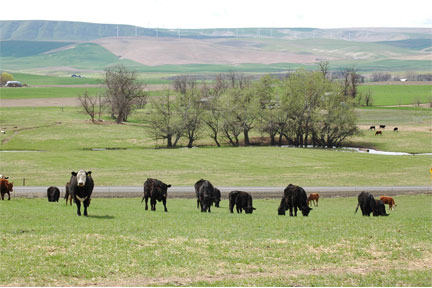
Agricultural News
Interpreting the Cattle Report: Revisions Make a Difference, But How Much?
Mon, 04 Feb 2013 13:15:08 CST

Derrell S. Peel, Oklahoma State University Extension Livestock Marketing Specialist, writes in the latest Cow-Calf newsletter that while the USDA has revised cattle numbers in a positive direction, cow herd rebuilding is still a ways off.
USDA's latest Cattle report changes our view of what the situation has been as well as what we can expect in the coming year. While the overall cattle inventory was unchanged, revisions to the 2012 numbers in several categories affect the interpretation of the report. The inventory of all cattle and calves was 89.3 million head, down 1.6 percent from the unrevised 2012 value.
The estimated inventory of beef cows on January 1, 2013 was 29.3 million head, down 2.9 percent from last year. However, the estimate for January 1, 2012 was increased by 275,000 head, which means that the decrease from 2011 to 2012 was not as severe as earlier indicated. Though the drop in beef cow numbers in 2012 was larger in percentage terms than pre-report estimates, the overall level of inventory is pretty close to what was expected. In other words, we had a bigger drop from a bigger total and ended up about where we thought we would be. Almost all of the revision in beef cow numbers was in Oklahoma and Texas suggesting that cow liquidation in 2011 was not as severe as earlier estimated in those two states. By contrast, Texas lost even more beef cows in 2012, down 12 percent, while Oklahoma beef cow numbers dropped a modest 1.3 percent in 2012.
The estimate for beef replacement heifers was also revised in the new report. For January 1, 2012, an additional 50,000 head of beef replacement heifers was added to the estimates for Nebraska and Oklahoma. This means that the inventory of beef replacement heifers at the beginning of 2012 was up 2.4 percent. The estimated inventory of beef replacement heifers for January 1, 2013 was up 1.9 percent year over year. The replacement heifers indicate, more than anything else, the contrast between what the industry would like to do compared to what they are able to do. Though the 2012 inventory of beef replacement heifers was up, the drought and continued beef cow liquidation meant that a very low percentage of those potential replacement heifers actually entered the herd. The 2013 numbers show are even more pronounced in this respect. The 2013 beef replacement heifer inventory is 18.3 percent of the beef cow herd inventory, the highest replacement percentage since 1995. However, it depends entirely on whether drought condition moderate to determine what percentage of those heifers may actually enter the herd in 2013. In any event, even with a larger pool of potential replacement heifers, the potential for herd expansion in 2013 is still rather limited. In would require another significant drop in beef cow slaughter combined with a high percentage of this heifer pool to be actually placed into the herd to achieve more than stabilization of beef cow herd numbers. Limited beef cow herd expansion is possible in 2013 but it will require almost perfect conditions with respect to cow culling and heifer placement. The ongoing drought conditions do not make that likely.
Finally, downward revisions in the 2012 estimates in other heifers and steers mean that the 2013 estimated feeder supply was actually up slightly, but from an even bigger decrease in the estimated 2012 feeder supply. The combined inventory of calves, steers and other heifers was down 1.5 percent but the decreased feedlot inventory resulted in a slight increase in the residual feeder supply. With a smaller forecasted 2013 calf crop and reduced cattle imports, the squeeze on feeder supplies will continue. Without continued reductions in feedlot inventories, the feeder supply will continue to shrink. And, if conditions permit, increased heifer retention will further squeeze feeder supplies in the coming years.
WebReadyTM Powered by WireReady® NSI
Top Agricultural News
More Headlines...



















